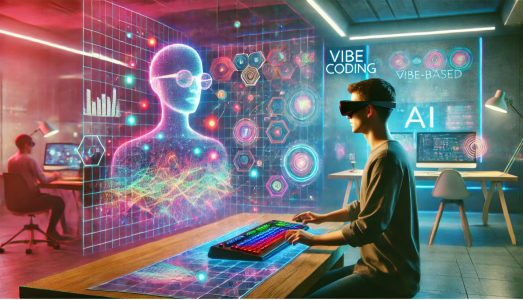Widgetized Section
Go to Admin » Appearance » Widgets » and move Gabfire Widget: Social into that MastheadOverlay zone
Vibe Coding in Government: How AI-Assisted Programming Can Transform Public Administration
The views expressed are those of the author and do not necessarily reflect the views of ASPA as an organization.
By Bill Brantley
March 21, 2025

Technological advancements are continuously transforming the delivery of services and interactions with citizens by government employees. One such innovation is “vibe coding,” an AI-assisted programming paradigm that empowers individuals, irrespective of their coding proficiency, to develop functional software applications. This article examines the concept of vibe coding, its potential applications within governmental contexts, and presents a hypothetical scenario illustrating its implementation.
Understanding Vibe Coding
Vibe coding is a technique where users describe desired outcomes in natural language, letting AI generate code. Introduced by Andrej Karpathy in 2025, it encourages collaboration between humans and AI to create applications without needing detailed coding knowledge. Users focus on functionality and design while AI manages code generation.
This method utilizes advanced AI tools that can interpret user prompts and generate code according to specified requirements. By engaging in an iterative dialogue with the AI, users can refine their applications, addressing errors and incorporating new features as necessary. This approach democratizes software development, making it accessible to individuals without formal programming education.
Applications of Vibe Coding in Government
Government agencies often struggle with limited resources, complex bureaucracy and the need for quick responses. Vibe coding helps by enabling employees to create custom apps that improve efficiency and service delivery. Here are ways vibe coding can benefit the public sector:
Process Automation: Vibe coding can automate routine tasks like data entry, scheduling and document processing, reducing staff workload and minimizing human error.
Citizen Engagement: Interactive platforms can be developed to improve communication between government agencies and citizens. For example, chatbots created through vibe coding can offer immediate responses to common questions, thereby improving public access to information.
Data Analysis and Visualization: Government employees have the capability to develop tools for analyzing large datasets, which generate visualizations that support decision-making and policy development. These applications can process real-time data, providing insights into areas such as public health trends or infrastructure utilization.
Training and Education: Custom e-learning platforms can be developed to train government staff in new policies, regulations or procedures. Vibe coding facilitates the rapid creation of these platforms, ensuring the timely dissemination of information.
Hypothetical Example: Developing a Public Feedback Application
A city government wants to improve public transportation by gathering citizen feedback. Using a vibe coding tool, an employee without coding experience can create a web app to collect and analyze this feedback.
Initiation: The employee uses a vibe coding platform to create a web app where citizens can rate and comment on public transportation services.
AI-Generated Prototype: The artificial intelligence system generates a preliminary web application, which includes input fields for ratings and comments along with a submission button.
Refinement: The employee reviews the prototype and requests additional features: “Add a dropdown menu for selecting transportation types (bus, train, etc.) and include a field for suggesting improvements.”
Error Handling: The employee observes errors with incomplete submissions and prompts the AI to require all fields before submission and display error messages for any missing data.
Data Analysis: To evaluate the collected feedback, the employee requests the AI to develop a dashboard that presents average ratings and recurring suggestions.
Deployment: Upon approval, the application is deployed on the city’s official website, allowing citizens to provide feedback and enabling the transportation department to access real-time data for informed decision-making.
Educational Resources on Vibe Coding
For individuals seeking to delve deeper into vibe coding, here are five YouTube videos that offer tutorials and valuable insights:
“Vibe Coding Is The Future” – This video explains the concept of vibe coding and its potential impact on software development.
“Vibe Coding Tutorial and Best Practices (Cursor / Windsurf)” – A detailed tutorial on vibe coding, including practices and tool recommendations.
“What is Vibe Coding?” – An overview of vibe coding and its possible uses.
“Vibe Coding with Wispr Flow and Cursor” – A detailed exploration of vibe coding utilizing specialized tools such as Wispr Flow and Cursor.
“Vibe Coding a FULL Game (AI Coding)” – Demonstrating vibe coding to create an entire game.
Vibe coding revolutionizes government software development by removing traditional barriers. Previously, creating applications required IT expertise, causing delays and limiting customization. Now, government workers use artificial intelligence to generate code from natural language prompts, crafting solutions for their needs. This innovation allows for automating tasks, engaging with citizens through interactive platforms and developing data analysis tools, all with minimal technical skills. Vibe coding makes software development accessible, enabling agencies to quickly adapt and streamline operations without extensive IT support.
As advancements in AI technology continue, vibe coding is anticipated to play a crucial role in the transformation of digital government. This technology empowers government employees to swiftly develop and refine applications, thus addressing complex societal challenges such as public health management, transportation optimization and resource allocation. Furthermore, it reduces dependence on external developers and lowers associated costs. However, achieving successful adoption will necessitate investment in AI literacy and training to ensure secure and effective utilization. Ultimately, this will reshape the design and delivery of public services in the digital era.
Author: Dr. Bill Brantley is the President and Chief Learning Officer for BAS2A, an instructional design consultancy for state and local governments. He also teaches at the University of Louisville, the University of Maryland, and Franklin University. His opinions are his own and do not reflect those of his employers. You can reach him at https://www.linkedin.com/in/billbrantley/.


Follow Us!